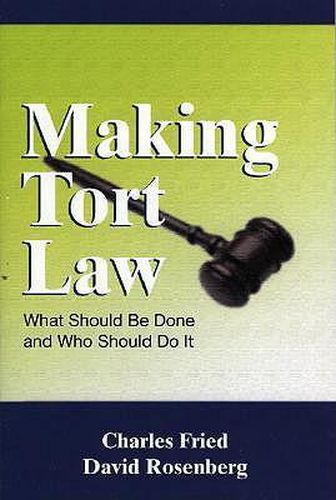Readings Newsletter
Become a Readings Member to make your shopping experience even easier.
Sign in or sign up for free!
You’re not far away from qualifying for FREE standard shipping within Australia
You’ve qualified for FREE standard shipping within Australia
The cart is loading…






Charles Fried and David Rosenberg note that the system of tort liability in the United States seeks to achieve a variety of aims: to compensate individuals injured by the risky business activities of large entities; to create incentives for those entities to take into account the dangers of their activities in the design of their processes, products, and services; and to allow individuals who feel powerless to make their grievances felt against large, impersonal, and sometimes unresponsive organizations. The authors contend, however, that our current tort system is almost certainly not the best possible way to achieve those goals. At best, they claim, tort compensation represents an uncertain, delayed, and expensive form of insurance. In addition, the disciplining effect on business is haphazard. Fried and Rosenberg assess the comparative advantages of courts and legislatures in taking the initiative of changing tort law to further the social objective of optimally managing accident risk. They conclude that the nature of the change involved-particularly the function that the change would serve and the means that would work best-strongly suggests that the legislature should play the major role in designing tort reform. And they contend that automobile and other nonbusiness-related accidents should be eliminated from the tort system.
$9.00 standard shipping within Australia
FREE standard shipping within Australia for orders over $100.00
Express & International shipping calculated at checkout
Charles Fried and David Rosenberg note that the system of tort liability in the United States seeks to achieve a variety of aims: to compensate individuals injured by the risky business activities of large entities; to create incentives for those entities to take into account the dangers of their activities in the design of their processes, products, and services; and to allow individuals who feel powerless to make their grievances felt against large, impersonal, and sometimes unresponsive organizations. The authors contend, however, that our current tort system is almost certainly not the best possible way to achieve those goals. At best, they claim, tort compensation represents an uncertain, delayed, and expensive form of insurance. In addition, the disciplining effect on business is haphazard. Fried and Rosenberg assess the comparative advantages of courts and legislatures in taking the initiative of changing tort law to further the social objective of optimally managing accident risk. They conclude that the nature of the change involved-particularly the function that the change would serve and the means that would work best-strongly suggests that the legislature should play the major role in designing tort reform. And they contend that automobile and other nonbusiness-related accidents should be eliminated from the tort system.